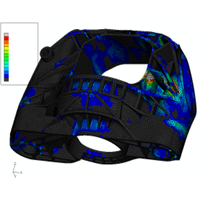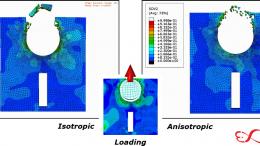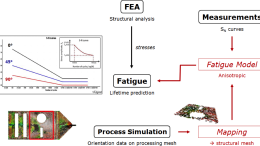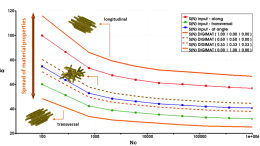
Progressive failure simulation in composite parts for Structural Engineering toward Fatigue and Durability analysis.
Anisotropic, heterogeneous and viscous material properties for failure behavior.
One of the most challenging tasks of design and development process is prediction of failure over time. Without knowledge of how a structure might fail, it is harder to improve its safety performance. Durability analysis from finite element models is becoming increasingly accepted in the design process.
The structural durability of a component is one of the most expensive attributes to test, thus one of the most appealing for CAE. Fatigue modeling of chopped and continuous fiber polymer composites is challenging due to their anisotropic, heterogeneous and viscous material properties as well as their process-dependent microstructure. In this context, the ability to model high cycle fatigue (HCF) of fiber reinforced composites was developed in Digimat.
Digimat has interfaces with all major fatigue codes (VirtualLab Durability, nCode DesignLife).
Digimat modeling platform is used to analyze fatigue and durability of various types of components in the industry:
- Aerospace:
Wings, panels, engine blades, rivets, bondings, valves, nacelles, interior component, etc. - Automotive:
Chassis, rivets, bolts, wheels, connecting rods, full body systems, door, seat, dashboard, interior component, drivetrain component, underhood, oil cooler bracket, front-end carrier, etc. - Biomedical:
Prosthesis, implants, etc. - Energy:
Pipes, vessel, valves, fan blade, wind turbines blade, pump body, etc. - Electronics:
Connectors, clips, electronic racks and housing assemblies,etc.
| Industries:
Automotive Material:Short fiber reinforced plastic Overview:This new engine mount, nowadays in cars on the road and initially made in metal, has been designed in short fiber reinforced plastic. The simulation has been addressed taking into account the heterogeneous field of fiber orientation. Digimat technology has allowed to define an optimized lightweight shape respecting the different objectives in terms of stiffness, strength and lifetime performances with a good level of correlation compared to the experimental tests. A total mass of 710g, which represents 40% of its initial weight, has been saved with in addition a reduction of cost of 15%. |
  DOWNLOAD DOWNLOAD |



